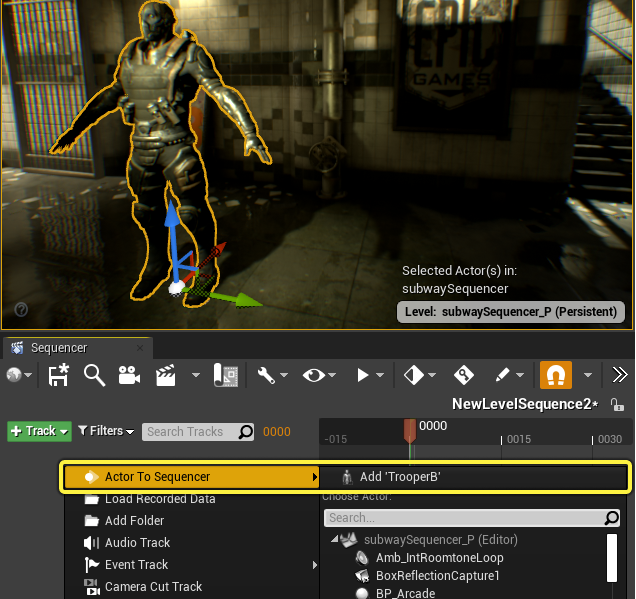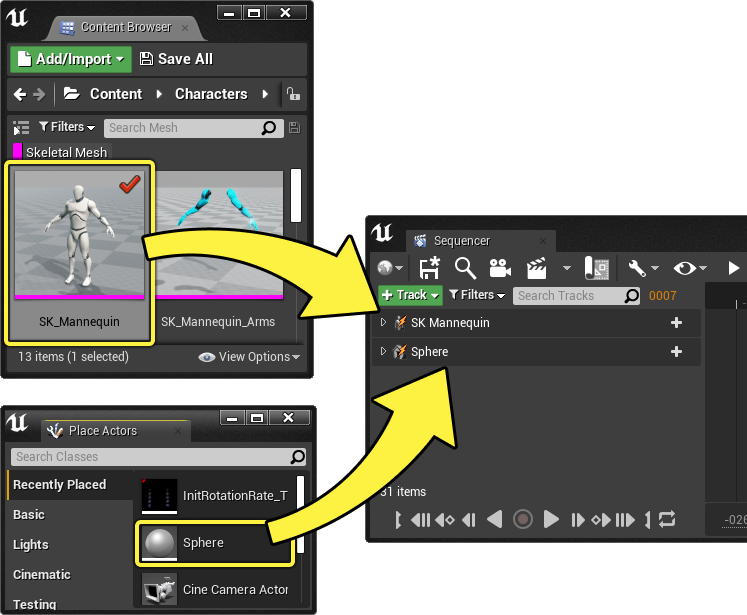Choose your operating system:
Windows
macOS
Linux
In Sequencer, you can choose to either reference an Actor that currently exists in the scene - referred to as a Possessable - or spawn a new Actor - referred to as a Spawnable . This document provides an overview of these concepts and how you can utilize them in your scenes.
Prerequisites
Possessable
Possessing Actors is done by adding or binding Actors that exist in the Level to your sequence.

Once an Actor is possessed, the sequence will be linked to the instance of that Actor in the current Level. In most cases this might be an acceptable or even preferable workflow. If your scene requires a high degree of interaction with currently existing Actors in a Level, then possessing is likely the best choice for referencing Actors.
Spawnable
In cases where your scene requires Actors that might be temporary for the duration of a scene, you can use Sequencer's Spawnable feature for creating temporary Actors. By default, when a sequence with a Spawnable Actor starts, the Actor will be spawned. When the sequence ends, the Actor will be destroyed and removed.
A Spawnable Actor in Sequencer is denoted by a lightning bolt overlay on the Actor's icon.
![]()
A Spawned property track that has been enabled is also required and will be created automatically when using Spawnable Actors. If this track is deleted or disabled, then the Actor will not appear. This track can be keyframed if you want to more accurately control when the Spawnable Actor will appear.

Creating a Spawnable Actor
Spawnable Actors can be added to your sequence in a few ways.
You can right-click a Possessable Actor and select Convert to Spawnable . This will copy and delete the current Actor in your Level and create a Spawnable Actor based on the copy in Sequencer instead.

A Spawnable Actor can be converted back to Possessable by doing the same steps. When that occurs, the Actor is re-created in your Level and the track binds to it, removing the Spawnable Actor.
Dragging an Actor from the Content Browser or Place Actors panels into the Sequencer Outliner will also add them as Spawnable Actors.

Properties
Spawnable Actors have various properties that control their behavior and interactions with Sequencer. These properties can be accessed by right-clicking the Spawnable bound track and locating the Spawnable category.

|
Property Name |
Description |
|---|---|
|
Spawned Object Owner |
Specifies which Level Sequence owns the Actor, which also determines the automatic spawn behavior.
|
|
Spawned Level |
Specifies which Level the Actor will spawn into. This list is determined by what Levels exist in your Levels window. |
|
Change Class |
Specifies the class that will rebind the spawned Actor to the chosen class from your project. |
|
Continuously Respawn |
When enabled, the Actor will continuously spawn every tick, ignoring any external destroy events. |
|
Evaluate Tracks When Not Spawned |
When enabled, all tracks from this Actor will still be evaluated even if the Actor is not spawned. This is useful if the Actor requires any preprocessing before being spawned. |
|
Net Addressable |
When enabled, this Spawnable Actor will be spawned using a unique name that allows it to be referenced by the server and client. |
|
Save Default State |
Saves the current state of this Spawnable Actor. Typically you do not need to click this as Unreal Engine will attempt to automatically save any changes to the Spawnable Actor. |
|
Convert to Possessable |
Converts the Actor to a Possessable Actor. When this occurs, the Actor is re-created in your Level and the track binds to it, removing the Spawnable Actor. |
Workflows
Spawnable Actors can help you create more organized scenes in terms of content organization and management. Examples of when or how you can use Spawnable Actors effectively are listed below.
Lighting Scenes
Instead of placing several lights in your Level that have to be manually enabled /disabled per shot, you can simply just add the required lights to your shot as Spawnable Actors. They will exist only for that shot, and not clutter your Level with unnecessary lights.

This workflow can also be used for any temporary Actor, such as particles.
Sequencer in Different Levels
If every Actor within your sequence is a Spawnable Actor, then it is possible to reference that sequence in multiple different Levels and have all the Actors appear. This will allow cutscenes to play in multiple Levels using the same spawned Actors.

